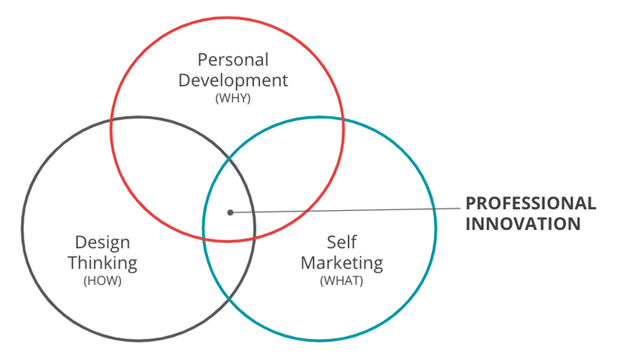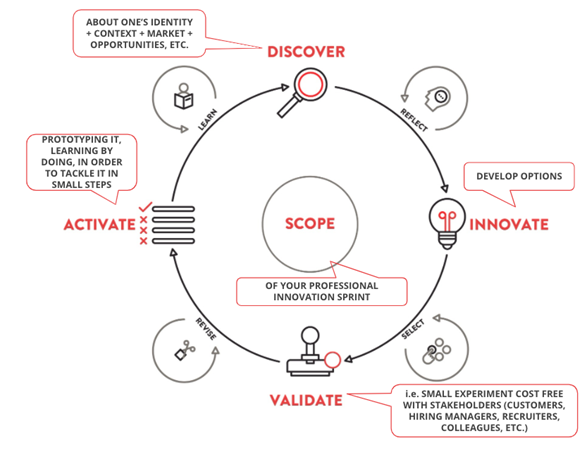ATD Blog
From Professional Development to Professional Innovation
Wed Nov 17 2021

Careers can no longer be thought of as a linear process in which each step is another notch closer toward a predefined goal. Instead, careers are more like a set of options that can be adapted to a person’s choices and desires and fluid enough to adjust to the needs of a changing world. Careers have become innovation processes that must be developed the same way we nurture and develop a small startup.
Much like a startup, people have a general scope (not a SMART goal) whether they’re conscious of it or not. They are motivated by the impact they want to create, their purpose. And to make this happen, they search for the most sustainable and scalable personal business model available at that precise moment in their life. We can say that in modern careers "the goal is to have a goal"!
Using a small business startup agile mentality and methodology, we have developed a values-based model for professional development that we renamed professional innovation.
Take Marcus. Marcus worked as an operations manager for a large home-appliance corporation. During a talent development program that included the professional innovation approach, he became aware of a strong personal interest he had neglected for a long time: the circular economy. He wanted his company to adopt this circular economy process with great benefit.
Marcus prototyped a personal branding strategy with the goal of influencing the most relevant internal stakeholders. Thus, he realized that strategic marketing, not operations, was clearly where the circular economy topic area was gathering the most traction and impact in his company.
Marcus also understood he needed to differentiate from his internal and external potential competitors. Thanks to a personal SWOT analysis, Marcus discovered that he lacked a strong support network but could differentiate himself by leveraging his former experience in raw material-procurement-related projects. And to fill all gaps and gather more insight, he decided to network more by temporarily getting involved in some innovation-focused projects within his company. He also took advantage of specific elective training opportunities, which were part of the talent development program, and enrolled in a part-time executive master course about circular economy at a major business school.
Thanks to his efforts and a new support network, he discovered how to apply the topic of the circular economy within his organization. He is discussing the creation of a new role with senior management that could potentially leverage all the discoveries for good.
Professional Innovation
To embark upon a new career journey, employees like Marcus benefit from this new methodology developed by my company BigName. BigName has been using this approach for the last decade in various organizations with great success. This helped us to define professional innovation as the combination of traditional personal development, design thinking, and strategic self-life marketing. The latter, in particular, is consistent with the typical enterprise/corporate mindset and can enable a more precise idea generation and validation.

The approach is a design thinking-based cycle made up of four distinct phases composed of four steps (DIVA) and four decision-making moments (RSRL).
This model shows you the three separate forms of why, what, and how. For the purposes of this blog post, we will focus on the how—the design thinking bubble of the model.

Borrowing a term well-known in Agile Software development circles, we called each single iteration a career sprint. After a career sprint, a worker (or sprinter) makes a SMART career move and pivots toward, for example, the development of strategic new skills or of a more sustainable career path before starting another career sprint.
Scope
If in modern careers "the goal is to have a goal," the professional innovation process should begin with the definition of a scope rather than that of a SMART GOAL. Much like in Marcus’ case, it could be an interest, a purpose, simply the idea of exploring a general opportunity, or including a new skill.
Discover
This stage is where the career sprinter researches with all their resources, such as personality and values assessments, journaling, and so on. But also strategic self-marketing tools as personal networks, personal SWOT analysis, personal branding, and personal business modeling assessment are the best ways to have a more comprehensive and realistic view of the relationship of the talent’s set of resources and skills and his “market.”
Innnovate
Here career sprinters develop as many options and scenarios as they can based on identified design criteria. Any tool for diverging and developing ideas can be employed here: brainstorming, mentoring, mind-mapping, and so on. Here again strategic self-marketing methodologies are crucial for devising realistic options.
Validate
To ensure an idea is more than a mere dream, this stage is set to test the feasibility, sustainability, credibility, and desirability of the scope. The goal is to make mistakes—the sooner, the better—before they become a major problem. We want to avoid unsustainable development investments. Any mockup tools will work, from simulations to stakeholder interviews, or even just joining a relevant side project or performing stakeholder interviews.
Activate
Validated and revised ideas are activated here using a prototyping approach. This builds on learning and marks your way forward one small step at a time.
A New Role for Talent Development Professionals
To innovate their profession, workers need to go through the four phases either learning them or being guided through them by a talent development professional empowered by this approach. Talent development professionals can then have a new role: from designers and providers of training programs or other professional development initiatives to professional innovation process facilitators.
In the era in which the centralized planning of professional development is getting ever more resource-intensive and the risk of proposing irrelevant solutions grows higher, the role of talent development professionals is becoming similar to that of the chief innovation officer. Indeed, now more than ever, there is the need for a new C-suite member, that of the chief talent innovation officer.
To find out more about this methodology and our visual thinking tool, visit here.
